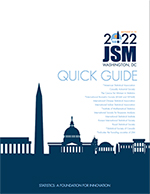Back
2022 Joint Statistical Meetings
Social Statistics Section
Session: Assessing Different Approaches to Combining Probability and Nonprobability Samples via Simulations
A Dual-Frame Estimation Approach for Combining Probability and Nonprobability Samples
Thursday, August 11, 2022
Activity Number: 544
-
Chien-Min Huang
Colorado State University
In some two-stage samples, primary sampling units (PSUs) are screened for secondary sampling units of interest, which are then measured or subsampled. PSUs without secondary units of interest are costly and time consuming. Motivated by the low yield of the Large Pelagics Intercept Survey, a two-stage screening sample for a rare type of fishing activity, we have considered surveys that allow expert judgment in selection of some PSUs. This nonprobability judgment sample is then combined with a probability sample to generate likelihood-based estimates of inclusion probabilities and estimators of population rates that are related to dual-frame estimators. We adapt and apply this dual-frame estimation technique to a common setting in modern survey practice, in which a probability sample representative of the population is combined with a nonprobability sample with undercoverage and completely unknown inclusion probabilities (unlike our original setting, in which inclusion probabilities are unknown under the judgment sampling but known under the original probability sampling design). We use statistical matching to address the undercoverage and assign initial design probabilities for the nonprobability sample. We model the conditional probability of inclusion in the nonprobability sample (given that an element was not included in the probability sample) parametrically, selecting and estimating the model via a pseudo-likelihood version of elastic net regression. We propose simple variance estimators. We apply the methods to the common test problem of this session (an artificial example built from the real study of Culture and Community in a Time of Crisis), and assess their behavior with respect to estimation bias, effective sample size, and confidence interval coverage.

